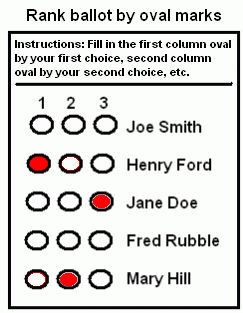Ranked Voting
 |
The term Ranked Voting, also known as preferential voting or ranked choice voting, pertains to any voting system where voters use a rank to order candidates or options—in a sequence from first, second, third, and onwards—on their ballots. Ranked voting systems vary based on the ballot marking process, how preferences are tabulated and counted, the number of seats available for election, and whether voters are allowed to rank candidates equally. An electoral system that utilizes ranked voting employs one of numerous counting methods to determine the winning candidate or candidates. Additionally, in some ranked voting systems, officials mandate voters to rank a specific number of candidates, sometimes all; while in others, voters may rank as many candidates as they desire. |
|---|---|
| wikipedia:: Ranked voting |
Wikipedia Synopsis
also known as preferential voting or ranked choice voting
Ranked Voting
Interactive graph
On this page
Ranked Voting